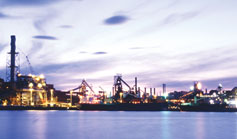YOU ARE HERE: CSE Report 2005 > Energy & Greenhouse > Energy & Greenhouse Gas Case Studies

Upgrade Improves Reliability and Saves Power
Conversion of Boiler to Gas Cuts Emissions
New Zealand Steel Undertaking World's Best Practice Study
Upgrade Improves Reliability and Saves Power
An upgrade to large induction fans at the Port Kembla Steelworks has not only improved their performance, it will also cut greenhouse gas emissions by thousands of tonnes per year.
The fans are attached to the Basic Oxygen Steelmaking (BOS) plant at Port Kembla. The BOS makes steel by blowing oxygen into a vessel, in the process removing carbon and releasing it as carbon dioxide and carbon monoxide. The carbon monoxide is released as carbon dioxide after flaring.
The BOS plant consists of three steel making vessels, with two vessels normally operational at any one time. The two vessels take turns in manufacturing steel.
The induction fans (each of which is 1.8 MW) capture the gases generated in the vessel, but because production from the vessels alternates, the fans operate at idle speed about 60 per cent of the time.
By upgrading the control mechanism for the fans, the idle speed was reduced and reliability improved. Reducing the idle speed of the fans saves about 6,500 Megawatt hours of electricity per year. This is equivalent to about 6,000 tonnes of carbon dioxide equivalent (CO2e) emissions per year.
Conversion of Boiler to Gas Cuts Emissions
In early 2005, a boiler at Port Kembla Steelworks was converted from coal to gas, eliminating tens of thousands of tonnes of coal consumed each year and cutting greenhouse gas emissions.
The boiler, which came back on line in May 2005, is now fuelled by a combination of blast furnace gas, coke ovens gas, and natural gas. Conversion of No.25 boiler from coal firing to gas firing has eliminated consumption of approximately 54,000 tonnes per year of coal middlings. This is equivalent to approximately 1.4 petajoules of energy per year and 134,000 tonnes of CO2-e per year.
New Zealand Steel Undertaking World's Best Practice Study
Since 1968, New Zealand Steel's fully integrated steel mill has produced flat steel products for both the New Zealand and export markets in the Pacific region. The steel mill employs 1200 people to produce over 600,000 tonnes of steel slabs per year.
New Zealand Steel's operations emit some 2 million tonnes of CO2-e per annum (including an allowance for electricity purchased from the grid).
In August 2005, after extensive correspondence, the New Zealand Government advised that New Zealand Steel was eligible to negotiate a Negotiated Greenhouse Agreement in relation to the Glenbrook and Waikato North Head business units.
The Government has introduced Negotiated Greenhouse Agreements for firms or industries that, as a result of a carbon tax, face significant risk to their competitiveness relative to producers in countries with less stringent climate change policies. When agreed, a Negotiated Greenhouse Agreement will provide a firm with either partial or full relief from a carbon tax which is due to come into force on 1st April 2007 at a rate of NZ$15/tonne CO2-e.
The Negotiated Greenhouse Agreement process calls for New Zealand Steel to develop a World's Best Practice Study, which consists of two parts - an audited CO2-e emissions inventory for the 2004 calendar year plus a determination of what New Zealand Steel's CO2-e emissions intensity should be at 31st December 2012 if the company were operating at world's best practice levels.
The methodology to be used during the Study has to be submitted to the Government's Validator and approved prior to the Study being performed. New Zealand Steel's ironmaking process is quite unique on a worldwide basis and the Terms of Reference for the Study produced by the Ministry for the Environment advises how to proceed in situations like this.
Hatch and Associates are performing this Study for New Zealand Steel and it is due to be completed by February 2006.

An upgrade to large induction fans at the Port Kembla Steelworks has not only improved their performance, it will also cut greenhouse gas emissions by thousands of tonnes annually.

New Zealand Steel is undertaking a study to benchmark its greenhouse gas emissions and intensity against world's best practice.
